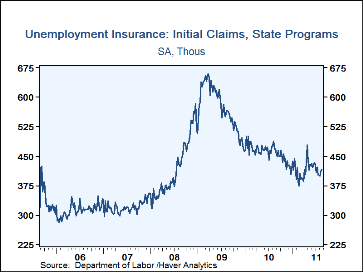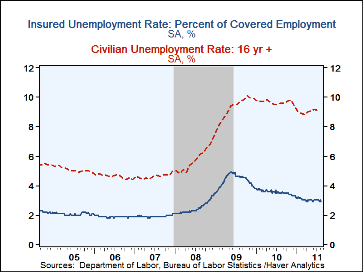 Global| Aug 25 2011
Global| Aug 25 2011U.S. Initial Claims for Unemployment Insurance Up 5K; Some Claims Related to Verizon Strike
Summary
Initial unemployment insurance claims remained above 400,000 yet again, but at least this week there is one good reason for this elevated level: the strike of union members against Verizon Communications. Indeed, the Labor Department [...]
 Initial unemployment insurance claims remained above 400,000 yet again,
but at least this week there is one good reason for this elevated level: the
strike of union members against Verizon Communications. Indeed, the Labor
Department cites this in a separate sentence above the text of its regular press
release. In the week ended August 20, initial claims were 417,000, up
from 412,000 the previous week (revised from 408,000). In the August 20
week, 8,500 of the claims were a direct result of the Verizon strike following
12,500 in the August 13 week. For the August 20 report, the Action
Economics consensus survey forecast looked for 405,000. The 4-week average
reached 407,500, up from 403,000 the prior week.
Initial unemployment insurance claims remained above 400,000 yet again,
but at least this week there is one good reason for this elevated level: the
strike of union members against Verizon Communications. Indeed, the Labor
Department cites this in a separate sentence above the text of its regular press
release. In the week ended August 20, initial claims were 417,000, up
from 412,000 the previous week (revised from 408,000). In the August 20
week, 8,500 of the claims were a direct result of the Verizon strike following
12,500 in the August 13 week. For the August 20 report, the Action
Economics consensus survey forecast looked for 405,000. The 4-week average
reached 407,500, up from 403,000 the prior week.
Continuing claims for unemployment insurance turned lower in the August 13 week, falling 80,000 to 3.641M and setting a new low since the autumn of 2008. The insured unemployment rate moved back down to 2.9% from 3.0% the week before. At the same time, of course, this group covers only those on regular state unemployment insurance programs. Data on various extended programs run by the States and the federal government yield a grand total of 7,290,189 claimants through August 6; this is a decrease of 45,989 from the week before that and a decline of 28.2% from a year ago. Regular extended benefits, with eligibility dependent on conditions in individual states, rose 23,413 to 550,903, but the special 2008 "EUC 2008" programs shrank by 43,827 to 3,086,781. As the week before, the regular extended benefits were available in 32 states and the District of Columbia, the Labor Department reported.
Data on weekly unemployment insurance programs are contained in Haver's WEEKLY database, including the seasonal factor series, and they are summarized monthly in USECON. Data for individual states, including the unemployment rates that determine individual state eligibility for the extended benefits programs and specific "tiers" of the emergency program, are in REGIONW, a database of weekly data for states and various regional divisions. Action Economics estimates are in AS1REPNA.
| Unemployment Insurance (000s) | 8/20/11 | 8/13/11 | 8/06/11 | Y/Y% | 2010 | 2009 | 2008 |
|---|---|---|---|---|---|---|---|
| Initial Claims | 417 | 412 | 399 | -11.1 | 459 | 574 | 418 |
| Continuing Claims | 3641 | 3,721 | -18.4 | 4,544 | 5,807 | 3,338 | |
| Insured Unemployment Rate(%) | 2.9 | 3.0 | 3.5 (8/14) |
3.6 | 4.4 | 2.5 | |
| Total "All Programs" (NSA) | -- | 7.290M | -28.2 | 9.850M | 9.163M | 3.903M |
Carol Stone, CBE
AuthorMore in Author Profile »Carol Stone, CBE came to Haver Analytics in 2003 following more than 35 years as a financial market economist at major Wall Street financial institutions, most especially Merrill Lynch and Nomura Securities. She has broad experience in analysis and forecasting of flow-of-funds accounts, the federal budget and Federal Reserve operations. At Nomura Securites, among other duties, she developed various indicator forecasting tools and edited a daily global publication produced in London and New York for readers in Tokyo. At Haver Analytics, Carol is a member of the Research Department, aiding database managers with research and documentation efforts, as well as posting commentary on select economic reports. In addition, she conducts Ways-of-the-World, a blog on economic issues for an Episcopal-Church-affiliated website, The Geranium Farm. During her career, Carol served as an officer of the Money Marketeers and the Downtown Economists Club. She has a PhD from NYU's Stern School of Business. She lives in Brooklyn, New York, and has a weekend home on Long Island.







